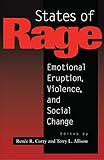States of Rage : On Cultural Emotion and Social Change / Renee R. Curry.
Material type: TextPublisher: New York, NY : New York University Press, [2021]Copyright date: ©1996Description: 1 online resourceContent type:
TextPublisher: New York, NY : New York University Press, [2021]Copyright date: ©1996Description: 1 online resourceContent type: - 9780814715253
- 9780814723692
- 152.47
- HN90.V5
- online - DeGruyter
| Item type | Current library | Call number | URL | Status | Notes | Barcode | |
|---|---|---|---|---|---|---|---|
 eBook
eBook
|
Biblioteca "Angelicum" Pont. Univ. S.Tommaso d'Aquino Nuvola online | online - DeGruyter (Browse shelf(Opens below)) | Online access | Not for loan (Accesso limitato) | Accesso per gli utenti autorizzati / Access for authorized users | (dgr)9780814723692 |
Frontmatter -- CONTENTS -- Acknowledgments -- Contributors -- Introduction: Invitation to Rage -- Part I. Social Constructions of Rage -- 1. Female Lives, Feminist Deaths: The Relationship of the Montreal Massacre to Dissociation, Incest, and Violence against Women -- 2. Violence, the Emotionally Enraged Employee, and the Workplace: Managerial Considerations -- 3. Over His Dead Body: Female Murderers, Female Rage, and Western Culture -- 4. Fuck Community, or Why I Support Gay-Bashing -- Part II . Artistic and Cultural Representations of Rage -- 5. Whatup in the 'Hood? The Rage of African-American Filmmakers -- 6. Rage and Remembrance: The AIDS Plays -- 7. The Aesthetic Politics of Rage -- 8. "All Anger and Understanding": Kureishi, Culture, and Contemporary Constructions of Rage -- 9. The Psychohistory of Jewish Rage and Redemption as Seen through Its Art -- 10. Aborted Rage in Beth Henley's Women -- 11. My Words to Victor Frankenstein Above the Village of Chamounix: Performing Transgender Rage -- Part III. Rage in the Academy -- 12. Class Matters: Symbolic Boundaries and Cultural Exclusion -- 13. Second-Rate or Second-Rank: The Human Pyramid of Academe -- 14. The Rage of Innocents: On Casting the First Stone in a Sea of Cultural Pain -- INDEX
restricted access online access with authorization star
http://purl.org/coar/access_right/c_16ec
States of Rage permeate our culture and our daily lives. From the anti-Catholic protests of ACT-UP to the political posturing of Al Sharpton, from the LA Riots to anti-abortion gunmen murdering clinic personnel, the unleashing of rage, marginalized or institutional, has translated into dead bodies on our campuses and city streets, in our public buildings and in our homes. Rage seems to have gained a currency in the past decade which it previously did not possess. Suddenly we appear willing to employ it more often to describe our own or others' mental states or actions. Rage succinctly describes an ongoing emotional state for many residents and citizens of the United States and elsewhere. States of Rage gathers for the first time a critical mass of writing about rage--its function, expression, and utilities. It examines rage as a cultural phenomenon, delineating its use and explaining why this emotional state increasingly intrudes into our social, artistic, and academic existences. What is the relationship between rage and power(lessness)? How does rage relate to personal or social injustice? Can we ritualize rage or is it always spontaneous? Finally, what provokes rage and what is provocative about it? Essays shed light on the psychological and social origins of rage, its relationship to the self, its connection to culture, and its possible triggers. The volume includes chapters on violence in the workplace, the Montreal massacre, female murderers, the rage of African- American filmmakers, rage as a reaction to persecution, the rage of AIDS activists, class rage, and rage in the academy.
Mode of access: Internet via World Wide Web.
In English.
Description based on online resource; title from PDF title page (publisher's Web site, viewed 06. Mrz 2024)


